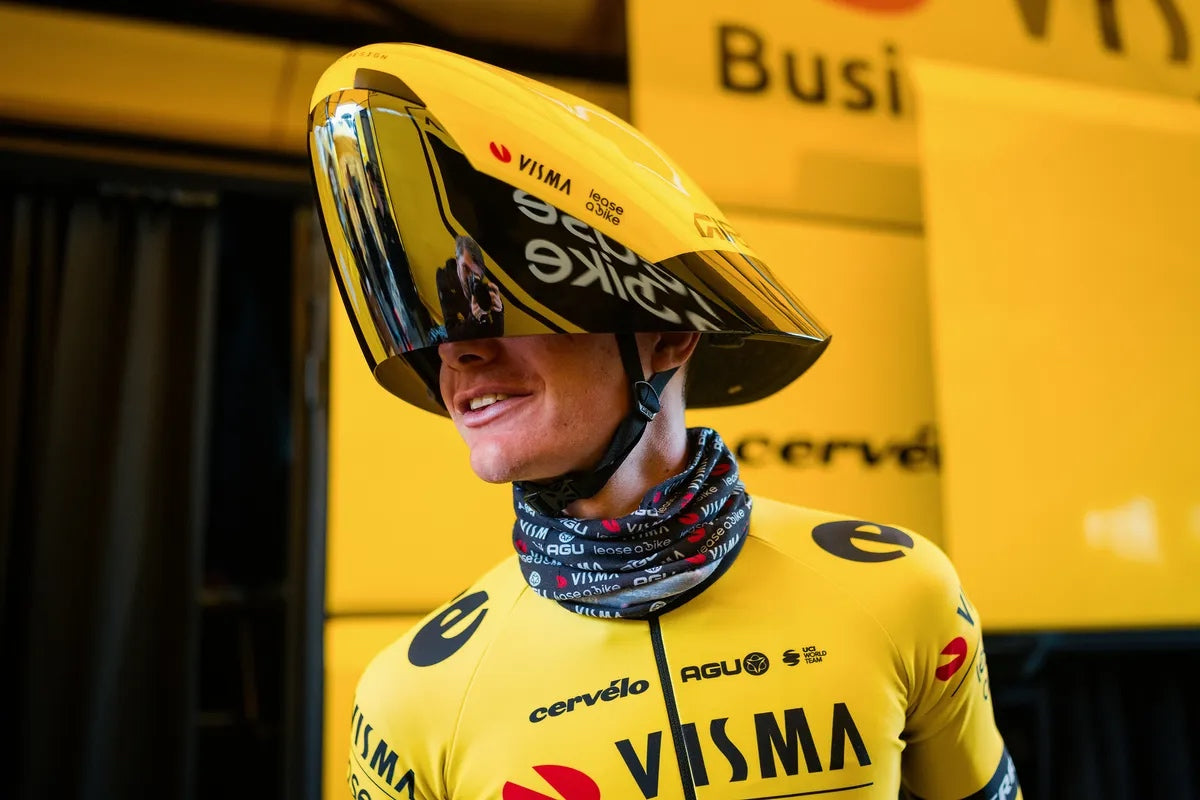Visma-Lease a Bike have posted photos of Jonas Vingegaard and other riders wearing a radical new Giro helmet in advance of the 10-kilometre time trial at Tirreno-Adriatico today.
The helmet has an extended front, almost like a nose cone, with a tall visor that’s designed not to impede riders’ vision when in the TT position. It flares at the sides before ending in an abrupt shelf that could work as a kamm-tail but most important will ensure that it fits into the UCI’s dimensional box constrains helmet size to sensible proportions (450mm long, 210mm high and 300mm wide).
 Venting looks very minimal – just a small mesh grille on the top and two either side of the visor top.
Venting looks very minimal – just a small mesh grille on the top and two either side of the visor top.
The new Giro helmet – whose name hasn’t yet been released – is the latest in a series of big helmets. Last year we saw the super-wide Sweet Protection Redeemer 2Vi on the heads of Uno-X while the year before the not-quite-so-wide S-Works TT5 with its integrated head sock debuted at the Tour de France. The original wide helmet was the POC Tempor, which first appeared in 2012 but made a comeback once it was discovered – by Dan Bigham and his HUUB Wattbike team.
We asked Xavier Disley of AeroCoach to evaluate the new Giro helmet’s design and possible resulting performance gains.
“It is pretty dramatic,” he suggested. “What we’re seeing more these days is obviously helmets trying to shield more of the rider behind them, hence the move to wider helmets.
 Image: Visma-Lease a Bike on X
Image: Visma-Lease a Bike on X
“Having the helmet extended forwards is something the Giro did with the old Aerohead and something that other people such as Ekoi did. That helmet was designed by Swiss Side and had a very pointy front end – basically trying to extend the airfoil. It shared a similar design idea – splitting the air early in front of the head, creating an angle towards the shoulders. If you have a helmet that’s short and fat, the air goes straight out to the shoulders, the angle is too steep and it’s not going to keep the airflow attached for long enough.”
However, Disley points out that a helmet that tests well in the wind tunnel might not be the fastest for every rider due to variations in position and body shape and size.
“If there’s only one version [of the new Giro helmet] with no adjustable bits it’s not going to work perfectly for everyone. That will be the case with this helmet. Other teams have cottoned onto this,” he notes. “FDJ, for example, wear unbranded helmets allowing their riders to use whatever tests fastest for them.”
However, he concludes: “With all the tech and testing available these days they must know what they’re doing, so it’s not likely to be a terrible helmet.”
As for the weight, it doesn’t look lightweight. “For a WorldTour time trial if it was on the heavy side that wouldn’t be an issue,” says Disley, “but for an Ironman triathlon you might struggle.”
And of course we have no idea what the price might be assuming the new helmet will be released. Watch this space for more detail as we get hold of it.































